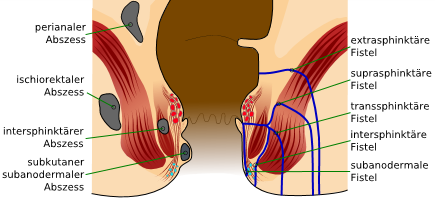 |
| Picture from Wikimedia Commons |
Perianal Abscess and Fistula
The recent article in Straits Times Mind and Body about perianal abscess and fistula
was a good read.
It highlights a very difficult problem many patients face. Firstly, it is a very painful infection in a very private area that you can't even check yourself. Many patients wait until the pain is unbearable before having the courage for a consultation. If the pain is severe, emergency surgery is required to relief the pain and prevent sepsis. Often, the patient has waited so long that the pus has drained spontanously. Unfortunately, that does not solve the problem. About half of these become recurrent even after surgical drainage. The article covered the very many surgical procedures available (none of which is very satisfactory in curing the disease). I would like to share some of the preventive habits adopted by patients which seems to help reduce recurrence.
- Adopt the WASH regimeWarm water, sitz bath. Sitting in warm salt water or just using the shower head over the site.Analgesics. Paracetamol and/or Ibubrufen to relief painStool . Ensure regular bowel motion. Probiotics / yogurt may help with this.High fibre diet with supplements if necessary.
- Avoid excessive cleansing. This may irritate the skin further. Try to wash with water instead of using tissue paper after bowel movements.
- Avoid hot spices. These may survive digestion and cause irritaion of the intestinal mucosa.
- Treat any other conditions of the anus eg pinworms, piles
- Sit less. If your work involves sitting for long streatches, take a walk and rest your eyes (and bum) every 45 minutes. Walk over to ask the question instead of using the phone, climb up instead of using the lift etc
- Regular excercise. About 30 minutes, 5 times a week. If that is not possible, just commit 10 minutes daily before your morning shower for a start. This is essential for regular bowel movement and you get a healthy heart as a bonus.
Most of the patients with perianal abscess require surgery for resolution. Even then, the recurrence rates are 30% to 40%. I think daily care is essential to reduce recurrence.
Dr Mohamed Ghazali
Dr Mohamed Ghazali

